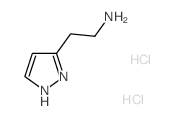138-92-1
| Name | betazole dihydrochloride |
|---|---|
| Synonyms |
1h-pyrazole-3-ethanamine,dihydrochloride
BETAZOLE HYDROCHLORIDE (200 MG) 3-(2-aminoethyl)-pyrazoldihydrochloride histalog [2-(1H-Pyrazol-3-yl)ethyl]amine dihydrochloride ametazoledihydrochloride Betazole hydrochloride 2-(1(2)H-pyrazol-3-yl)-ethylamine,dihydrochloride gastramine 2-(1(2)H-Pyrazol-3-yl)-aethylamin,Dihydrochlorid 3-(2-aminoethyl)pyrazole,dihydrochloride Histimin |
| Description | Betazole (Ametazole) dihydrochloride, a pyrazole analogue of histamine, is an orally active H2 receptor agonist. Betazole dihydrochloride induces gastric acid secretion, and causes an immediate and significant increase in common bile duct pressure. Betazole dihydrochloride has been used as a diagnostic agent known as histalog, for investigating gastric acid secretory capacity[1][2][3]. |
|---|---|
| Related Catalog | |
| Target |
H2 Receptor |
| In Vitro | Betazole (Ametazole) dihydrochloride is a weak histamine agonist with relative selectivity towards H2 receptors and only minimal H1 activity. Betazole dihydrochloride induces gastric inhibitory polypeptide (GIP) secretion[1]. |
| References |
| Boiling Point | 284.1ºC at 760mmHg |
|---|---|
| Melting Point | 224-226° |
| Molecular Formula | C5H11Cl2N3 |
| Molecular Weight | 184.06700 |
| Flash Point | 150.3ºC |
| Exact Mass | 183.03300 |
| PSA | 54.70000 |
| LogP | 2.21520 |
| Vapour Pressure | 0.00303mmHg at 25°C |
| Storage condition | 2-8°C |
CHEMICAL IDENTIFICATION
HEALTH HAZARD DATAACUTE TOXICITY DATA
|
| Hazard Codes | Xn |
|---|---|
| RIDADR | NONH for all modes of transport |
| HS Code | 2933199090 |
| HS Code | 2933199090 |
|---|---|
| Summary | 2933199090. other compounds containing an unfused pyrazole ring (whether or not hydrogenated) in the structure. VAT:17.0%. Tax rebate rate:13.0%. . MFN tariff:6.5%. General tariff:20.0% |
